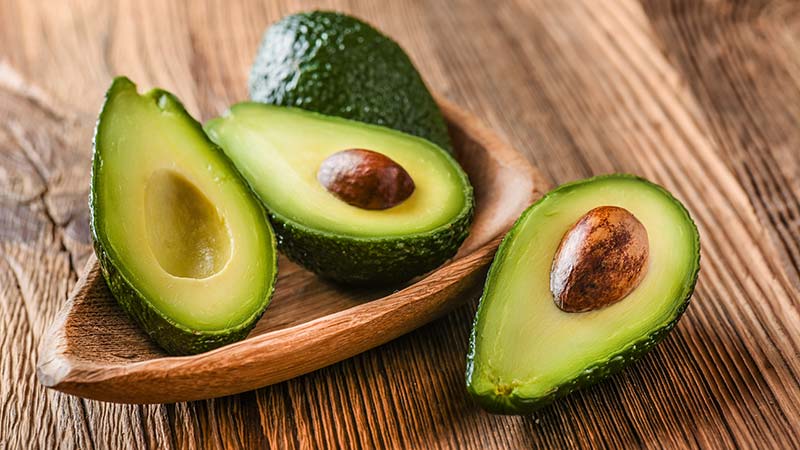
It’s a fruit! It’s a vegetable! No, it’s a superfood! The good and the bad of this ancient green plant.
Actually, the avocado is a berry. This million-plus year old tree grew in many regions around the world, but the more modern version (Persea americana) may have been domesticated in Central and South America. The ancient Aztecs believed the fruit to have aphrodisiac qualities. Eating an avocado can sure make you feel good, whether as a meal, snack or even dessert.
Real superfoods are natural, unprocessed items with very high quality nutritional profiles.
Here are three more benefits of eating the right kind of avocados:
- The high nutritional value.
- Increased fat-burning (especially with sour cream, salsa and hot peppers).
- The reduction of hunger.
- They’re absolutely delicious.
Today most avocados are grown in Mexico, with California, Chile, Peru and New Zealand among the many other host countries. However, as demand has increased, you find them growing in all tropical and Mediterranean climates around the world.
While defining just what is a fruit, vegetable, or berry can be a bit confusing and it’s not precise, they are all clearly and simply plant foods. Typically, plants with a seed are fruits, but we tend to think of some less-sweet fruits like avocados as vegetables. Whatever you call them, I highly recommend eating them regularly.
While I try to avoid trendiness, often poking fun of the related social quirkiness attached to it, the avocado craze has been fun to watch over the decades. Early on, few would buy these greenish-black bumpy things. After all, inside they were a green blob of fat. With less demand, the price was relatively high. Most people avoided them, occasionally dipping into them with chips when dining out, or nibbling on the tiny bits in a salad. Then, as the trend developed, people started liking them, and as they got more popular, the prices rose. Now, half the restaurants in the U.S. serve avocados.
Today, people use them as a big part of a meal — or even eat one as a meal. While I also avoid talking about any one perfect food, avocado would be part of an almost perfect healthy meal, which, of course, varies depending on whom is eating it. I like mine plain with sea salt, sometimes having cheese with it for a great, quick, easy and satisfying meal. Sometimes I combine the sour cream spicy salsa option on top of eggs. It’s also great in a smoothie!
However, health-conscious consumers should beware. Unfortunately, an avocado is not always a real avocado!
With the new millennium came the popularity of a new breed of genetically modified, low-fat avocado. Thanks to agriculture scientists, it’s a left-over remnant of the low-fat era — and it’s really low-fat! As a result, they don’t taste as good as the real thing. Grown in Florida, with some found in the Caribbean and Central America, they have only been a niche-market product. The nutritional difference is important.
Two tablespoons of a Hass avocado contain 50 calories including 4.6 grams of fat, while that amount of the low-fat Florida avocado averages 36 calories and 3 grams of fat. Most of the fat is the healthy monounsaturated, about 17 of the 27 grams, and most of the carbohydrate is fiber (about 12 of the 15 grams).
Fortunately, Florida avocados have not caught on — perhaps 90 percent of the market today wants the real deal, Hass, which is most of the world’s production (other similar versions exist as well).
When avocado supplies are high, they are scooped out and sold in a tub. But be advised that many of these products have unhealthy ingredients, like sugar, added so read the label.
The buttery flavor of a Hass avocado is unique, and delicious, and even called “butter fruit” in parts of India. This is due to the high healthy fat content. Along with high fiber and low-carb, this makes it a perfect food for the Two-Week Test, the Keto Two Week Test, and for those keeping carbohydrate foods low and fat high. It even has a few grams of protein.
Avocados are also relatively high in vitamins (including folate) and minerals (with more potassium than bananas), including antioxidants. They’re also great mashed up for babies just starting to eat solid food at around six months. And, if you want a great green treat, see my recipe for avocado pudding!
Adding avocados to your menu can reduce cardiovascular disease risk by improving cholesterol balance by raising HDLs and lowering total and LDL cholesterol (and triglycerides), perhaps due to the high monounsaturated fat (a Mediterranean ‘diet’ effect). Another benefit is its great satiating properties. Have a half, or whole avocado, and you feel full. Add more protein, like a slice or two of cheese, and you have a small meal or delicious snack.
Another plus for avocados is that even the conventional versions are very low in pesticide residues according to The Environmental Working Group. In fact avocado tops their “Clean 15” list.
Although avocado costs vary with the season, production and demand, prices increased 40 percent between 2015 and 2017, then in 2019 dramatically jumped in the U.S. almost as much, as the U.S. president threatened to close the border with Mexico.








